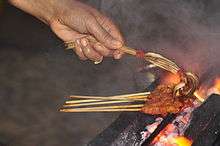Sauce
In cooking, a sauce is a liquid, cream, or semi-solid food, served on or used in preparing other foods. Most sauces are not normally consumed by themselves; they add flavor, moisture, and visual appeal to a dish. Sauce is a French word taken from the Latin salsa, meaning salted. Possibly the oldest recorded European sauce is garum, the fish sauce used by the Ancient Romans; while doubanjiang, the Chinese soy bean paste is mentioned in Rites of Zhou in the 3rd century BC.
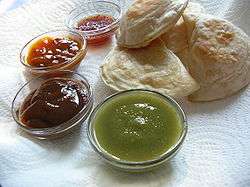
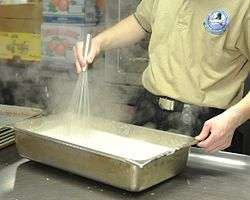
Sauces need a liquid component. Sauces are an essential element in cuisines all over the world.
Sauces may be used for sweet or savory dishes. They may be prepared and served cold, like mayonnaise, prepared cold but served lukewarm like pesto, cooked and served warm like bechamel or cooked and served cold like apple sauce. They may be freshly prepared by the cook, especially in restaurants, but today many sauces are sold premade and packaged like Worcestershire sauce, HP Sauce, soy sauce or ketchup. Sauces for salad are called salad dressing. Sauces made by deglazing a pan are called pan sauces.
A chef who specializes in making sauces is called a saucier.
Cuisines
Asian
- Sauces used in traditional Japanese cuisine are usually based on shōyu (soy sauce), miso or dashi. Ponzu, citrus-flavored soy sauce, and yakitori no tare, sweetened rich soy sauce, are examples of shōyu-based sauces. Miso-based sauces include gomamiso, miso with ground sesame, and amamiso, sweetened miso. In modern Japanese cuisine, the word "sauce" often refers to Worcestershire sauce, introduced in the 19th century and modified to suit Japanese tastes. Tonkatsu, okonomiyaki, and yakisoba sauces are based on this sauce. Japanese sauce or wasabi sauce is used on sushi and sashimi or mixed with soy sauce to make wasabi-joyu.
- Some sauces in Chinese cuisine are soy sauce, doubanjiang, hoisin sauce, sweet bean sauce, chili sauces, oyster sauce, and sweet and sour sauce.
- Korean cuisine uses sauces such as doenjang, gochujang, samjang, aekjeot, and soy sauce.
- Southeast Asian cuisines, such as Thai and Vietnamese cuisine, often use fish sauce, made from fermented fish.
- Indian cuisines use sauces such as tomato-based sauces with varying spice combinations (mistakenly referred to as generically "curry" by some Western cultures, initially due to British generalization of Indian sauces and spice blends), tamarind sauce, coconut milk-/paste-based sauces, and chutneys. There are substantial regional variations in Indian cuisine, but many sauces use a seasoned mix of onion, ginger and garlic paste as the base of various gravies and sauces. Various cooking oils, ghee and/or cream are also regular ingredients in Indian sauces.
- Filipino cuisine typically uses "toyomansi" (soy sauce with kalamansi lime) as well as different varieties of suka, patis, bagoong and banana ketchup, among others.
- Indonesian cuisine uses typical sauces such as kecap manis (sweet soy sauce), bumbu kacang (peanut sauce) and tauco, while popular hot and spicy sauces are sambal, dabu-dabu and rica-rica.
British
In traditional British cuisine, gravy is a sauce used on roast dinner. The sole survivor of the medieval bread-thickened sauces, bread sauce is one of the oldest sauces in British cooking. Apple sauce, mint sauce and horseradish sauce are used on meat (usually on pork, lamb and beef respectively). Redcurrant jelly, mint jelly, and white sauce may also be used. Salad cream is sometimes used on salads. Ketchup and brown sauce are used on fast-food type dishes. Strong English mustard is also used on various foods, as is Worcestershire sauce. Custard is a popular dessert sauce. Other popular sauces include mushroom sauce, marie rose sauce (as used in a prawn cocktail), whisky sauce (for serving with haggis), Albert sauce (horseradish sauce to enhance flavour of braised beef) and cheddar sauce (as used in cauliflower or macaroni and cheese). In contemporary British cuisine, owing to the wide diversity of British society today, there are also many sauces that are of British origin but based upon the cuisine of other countries, particularly former colonies such as India.[1]
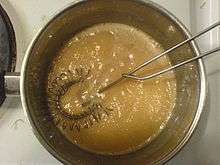
French

Sauces in French cuisine date back to the Middle Ages. There were many hundreds of sauces in the culinary repertoire. In cuisine classique (roughly from the end of the 19th century until the advent of nouvelle cuisine in the 1980s), sauces were a major defining characteristic of French cuisine.
In the early 19th century, the chef Marie-Antoine Carême created an extensive list of sauces, many of which were original recipes. It is unknown how many sauces Carême is responsible for, but it is estimated to be in the hundreds. The cream sauce, in its most popular form around the world, was concurrently created by another chef, Dennis Leblanc, working in the same kitchen as Carême. Carême considered the four grandes sauces to be espagnole, velouté, allemande, and béchamel, from which a large variety of petites sauces could be composed.[2]
In the early 20th century, the chef Auguste Escoffier refined Carême's list of basic sauces in the four editions of his classic Le Guide Culinaire[3] and its abridged English translation A Guide to Modern Cookery. He dropped allemande as he considered it a variation of velouté,[4] and added hollandaise and sauce tomate, defining the five fundamental "mother sauces" still used today:
- Sauce béchamel, milk-based sauce, thickened with flour
- Sauce espagnole, a fortified brown veal stock sauce, thickened with a brown roux
- Sauce velouté, light stock-based sauce, thickened with a roux or a liaison, a mixture of egg yolks and cream
- Sauce hollandaise, an emulsion of butter and lemon (or vinegar), using egg yolk as the emulsifier
- Sauce tomate, tomato-based
A sauce which is derived from one of the mother sauces by augmenting with additional ingredients is sometimes called a "daughter sauce" or "secondary sauce".[5] Most sauces commonly used in classical cuisine are daughter sauces. For example, béchamel can be made into Mornay by the addition of grated cheese, and espagnole becomes bordelaise with the addition of reduction of red wine, shallots, and poached beef marrow.
A specialized implement, the French sauce spoon, was introduced in the mid-20th century to aid in eating sauce in French cuisine, enjoying increasing popularity at high-end restaurants.
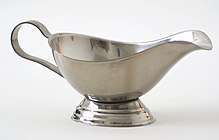
Italian
Italian sauces reflect the rich variety of the Italian cuisine and can be divided in several categories including:
Savory sauces used for dressing meats, fish and vegetables
Examples are:
- Besciamella from Tuscany and Emilia-Romagna
- Bagna càuda from Piedmont
- Salmoriglio from Sicily
- Gremolata from Milan
- Salsa verde from Emilia-Romagna and Tuscany
Savory sauces used to dress pasta dishes
.jpg)
There are thousands of such sauces, and many towns have traditional sauces. Among the internationally well-known are:
Dessert sauces
- Zabaione from Piedmont
- Crema pasticciera made with eggs and milk and common in the whole peninsula
- "Crema al mascarpone" used to make Tiramisù and to dress panettone at Christmas and common in the North of the country.
Latin and Spanish American
- Salsas ("sauces" in Spanish) such as pico de gallo (tomato, onion and chili chopped with lemon juice), salsa cocida, salsa verde, chile, and salsa roja are a crucial part of many Latin and Spanish-American cuisines in the Americas. Typical ingredients include chili, tomato, onion, and spices; thicker sauces often contain avocado. Mexican cuisine features sauces which may contain chocolate, seeds, and chiles collectively known by the Nahua name mole (compare guacamole).
- Peruvian cuisine uses sauces based mostly in different varieties of ají combined with several ingredients, most notably salsa huancaína based on fresh cheese and salsa de ocopa based on peanuts or nuts.
Middle Eastern
- Fesenjān is a traditional Iranian sauce of pomegranates and walnuts served over meat and/or vegetables which was traditionally served for Yalda or end of winter and the Nowruz ceremony.[6][7][8]
- Hummus is a traditional middle eastern sauce or dip. It originated in Egypt, but is considered as a traditional food of many Arab countries such as Syria and Palestine. It's made of chickpeas and tahina (sesame paste) and garlic with olive oil, salt and lemon juice.
Caucasian
- Ajika is a spicy hot sauce originating in Abkhazia, widely used in Georgian cuisine and found also in parts of Russia, Turkey, and Azerbaijan.
- Ships (sauce) is a traditional sauce of Circassian cuisine, made on a base of meat broth with pounded garlic, pepper, and sour milk or cream.[9]
- Tkemali is a tart and savoury traditional Georgian sauce of cherry plums in combination with various spices, including garlic, pennyroyal, coriander, dill, and chili.
Argentine
- Chimichurri is an uncooked sauce used both in cooking and as a table condiment for grilled meat.
Examples
 Mushroom sauce
Mushroom sauce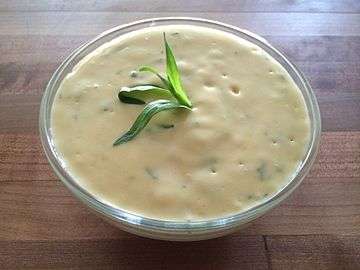 Sauce béarnaise or Béarnaise sauce.
Sauce béarnaise or Béarnaise sauce.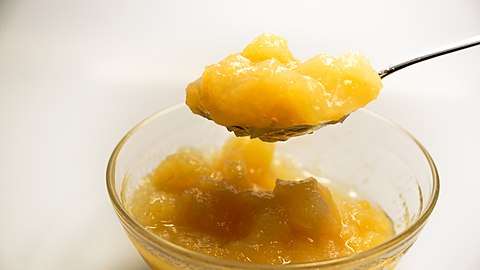 Apple sauce
Apple sauce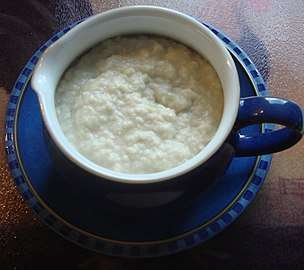 Bread sauce
Bread sauce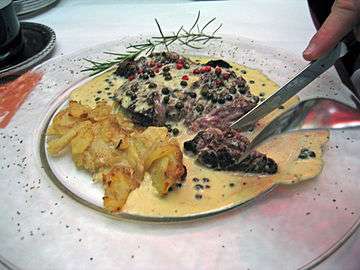 A beef steak served with peppercorn sauce
A beef steak served with peppercorn sauce
See also
- Pickle
- Chutney
- Condiment
- Coulis
- Dip
- List of dips
- Gastrique
- Gravy
- List of foods
- List of condiments
- List of dessert sauces
- List of sauces
- Peanut sauce
- Salad dressing
- Salsa
- Sambal
- Saucery
- Sofrito
References
Footnotes
- Colin Spencer (2011). British Food: An Extraordinary Thousand Years of History. Grub Street Publishers. ISBN 9781908117779. Retrieved 13 January 2020.
- Carême, Marie Antonin (1854). L'art de la cuisine française au dix-neuvième siècle (in French). 3. Paris: Au Depot de librairie. p. 1. Retrieved 7 December 2013.
- Escoffier, Auguste; Gilbert, Philéas; Fétu, E.; Suzanne, A.; Reboul, B.; Dietrich, Ch.; Caillat, A.; et al. (1903). Le Guide Culinaire, Aide-mémoire de cuisine pratique (in French). Paris: Émile Colin, Imprimerie de Lagny. Archived from the original on 4 January 2014. Retrieved 7 December 2013.
- Escoffier, Auguste (1907). A Guide to Modern Cookery. London: William Heinemann. pp. 2, 15. Retrieved 7 December 2013.
- "Small Sauce". Archived from the original on 14 February 2017. Retrieved 31 December 2016.
- Sifton, Sam. "Fesenjan". cooking.nytimes. Nytimes.
- Khoresht-e, Fesenjan. "Persian Food Primer: 10 Essential Iranian Dishes". Tasnim. Tasnim news. Retrieved 21 September 2016.
- Noll, Daniel. "Iranian Food: A Culinary Travel Guide to What to Eat and Drink". uncorneredmarket. Retrieved 8 December 2018.
- Jaimoukha, Amjad. "Circassian Cuisine" (PDF). CircassianWorld.com. Retrieved 15 July 2019.
Citations
- Peterson, James (1998). Sauces. John Wiley & Sons. ISBN 0-471-29275-3.
- Sokolov, Raymond (1976). The Saucier's Apprentice. Knopf. ISBN 0-394-48920-9.
- McGee, Harold (1984). On Food and Cooking. Macmillan. ISBN 0-02-034621-2.
- McGee, Harold (1990). The Curious Cook. Macmillan. ISBN 0-86547-452-4.
Further reading
- Corriher, Shirley (1997). "Ch. 4: sauce sense". Cookwise, the Hows and Whys of Successful Cooking (1st ed.). New York: William Morrow & Company, Inc. ISBN 0688102298.
- Murdoch (2004) Essential Seafood Cookbook Seafood sauces, p. 128–143. Murdoch Books. ISBN 9781740454124
External links
| Wikiquote has quotations related to: Sauce |
| Wikimedia Commons has media related to Sauces. |
| Wikibooks Cookbook has a recipe/module on |
